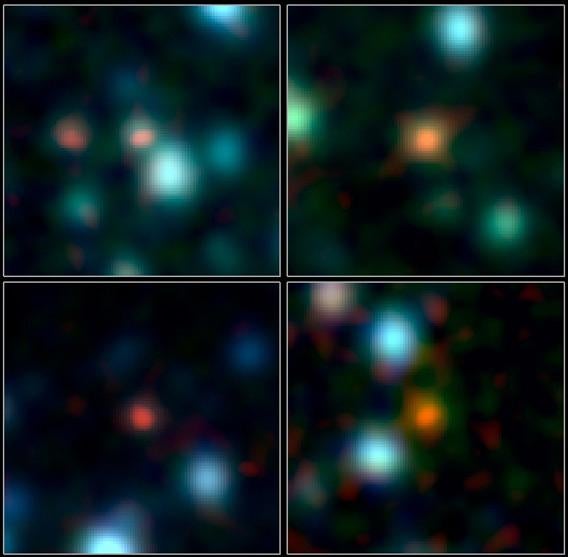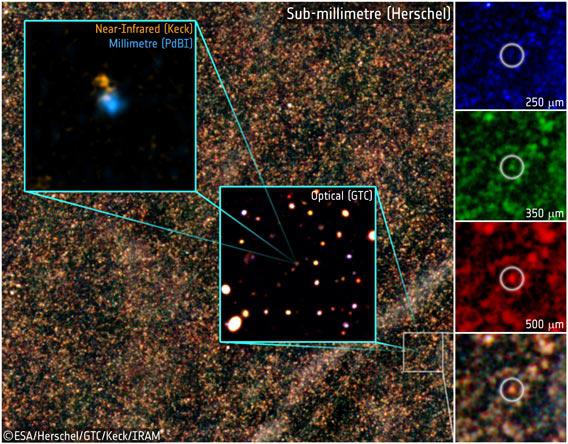Stars are a bit like people: They are born, live out their existence, and die. In galaxies like our Milky Way, if you collected all the stars born every year you’d find they add up to very roughly the same mass as the Sun. Different studies yield different numbers, but they only vary from about one to about four times the mass of the Sun.
Things were different when the Universe was young, though. New observations found a passel of galaxies churning out stars at the rate of 80 times the mass of the Sun every year. Not only that, but one distant galaxy was recently found that is cranking out newborns at the fantastic rate of about 3000 solar masses per year! This galaxy is almost literally exploding with star formation.
We know lots of galaxies have high star-formation rates; we see a few locally, but we see more the farther away we look. Looking away in distance is like looking back in time, because it takes time for light to get from the galaxy to us. The actual physics is a bit complicated, but essentially we see a galaxy a billion light years away as it was a billion years ago. The Universe is 13.8 billion years old, and galaxies started forming shortly thereafter, so by looking at extremely distant galaxies we’re probing what the Universe was like at a very young age.
The galaxy called HFLS3 was found using the orbiting Herschel observatory, which sees in the far infrared. Galaxies churning out stars also make lots of molecules we call dust; these clouds of dust absorb visible light but let infrared through. That makes them prime targets for Herschel.
Combing through vast amounts of Herschel data, astronomers found five candidate ultra-red sources consistent with starburst galaxies, and one, HFLS3, was found to be distant indeed: they determined the distance is a whopping 13 billion light years away, meaning the Universe itself was only 800-900 million years old when the light we see left the galaxy.
That actually is something of a problem. Current understanding of how stars form show that a galaxy at that young age shouldn’t be able to make them that vigorously! In fact, the galaxy appears to be almost as large as our Milky Way—about a hundred billion stars strong—which is incredible, given how short a time it had been around.
That in turn means our models of star formation need some work. The galaxy is there, and it does appear to be incredibly fecund. If the current physical models have a hard time replicating it, then we need to figure out why. Maybe conditions that long ago aren’t exactly what we expect, and that affects the rate of star birth. Or maybe this galaxy is just weird in some way, and is a very rare beast, with some unusual characteristics that allow it to furiously cook stars.
That’s actually good news; observations that strain the models mean we have to learn more, and scientists love that. It’s a weird profession, where finding out you’re wrong is cause for joy.

Image credit: ALMA (ESO/NAOJ/NRAO), J. Hodge et al., A. Weiss et al., NASA Spitzer Science Center
And we’re going to learn more. On top of the discovery of HFLS3, the brand-spanking-new radio observatory ALMA has some news of its own: It was pointed at an area of the sky known to contain starburst galaxies, and was able to clearly see over a hundred of them. Not only that, but ALMA is so sensitive it was able to make these observations needing only about two minutes per galaxy!
ALMA observed a region of the sky called the Chandra Deep Field South, where several telescopes have spent quite a lot of time taking very long exposure images, peering very deeply into the Universe. We knew there were galaxies in that area making lots of stars, but our best observations showed them as fuzzy blobs, overlapping with nearer galaxies. ALMA has very sharp vision, however, and was able to separate out the starburst galaxies, getting nice clear shots of them. This will allow astronomers to draw far better conclusions about the galaxies themselves.
The distances to these objects isn’t well known, but it’s likely they’re 10 or so billion light years, a long way off. Given that, they’re making something like 80 solar masses worth of stars per year, a pretty high rate. The galaxies themselves are smallish, or at least the regions in them making stars are, measured to be about 30,000 light years across, about a third the size of the Milky Way.
All of this information will be useful in understanding how stars formed in the early Universe. Perhaps the ALMA observations will have a direct impact on how we can figure out HFLS3.
This is all pretty cool. I’ve been an astronomer a long time, and every now and again I have to sit back and shake my head in wonder. We can take the measure of an object like HFLS3, even though it’s 130 billion trillion kilometers away—written out, that’s 130,000,000,000,000,000,000,000,000 kilometers!
Yikes. Yet there it is, popping out stars furiously, making our galaxy look sedate and lazy by comparison. And with ALMA now online we’ll be able to analyze distant galaxies better, as well as a host of other exotic and fascinating objects like exploding stars, gas clouds, and hyperactive black holes blasting out huge jets of material.
There’s been a lot of bad news lately when it comes to human affairs. But when I see news like this, I become optimistic. When we want to, when we choose to, our sight reaches clear across the cosmos, and we sift through the very material making up the Universe. We can peer back in time to the fires of the Big Bang, and determine how it is that conditions back then led to our existence now.
These are the some of the biggest questions we can ask—How did the Universe form? Why is the something rather than nothing?—and it’s through curiosity, through sheer joy of exploration, and through science that we can find the answers.
